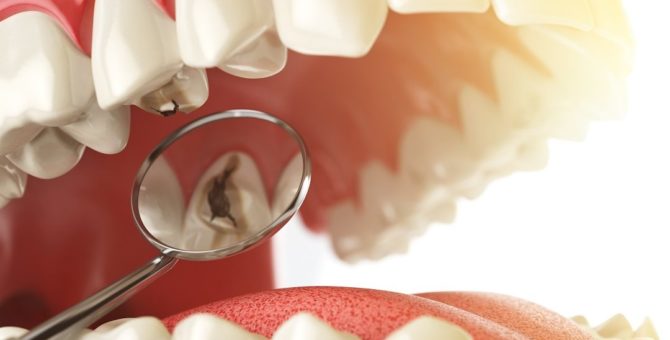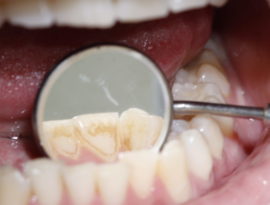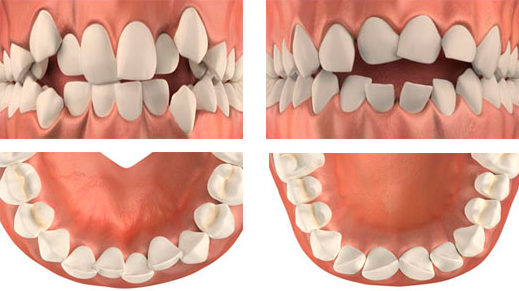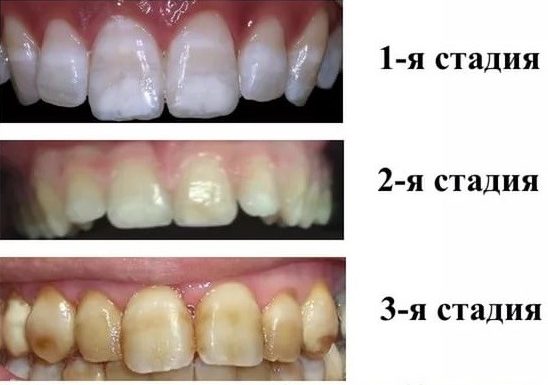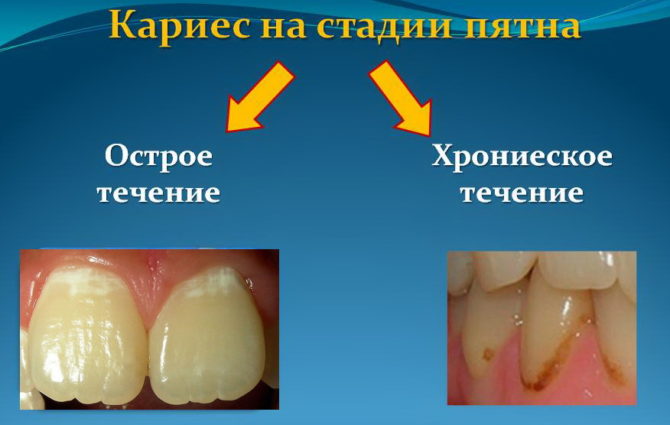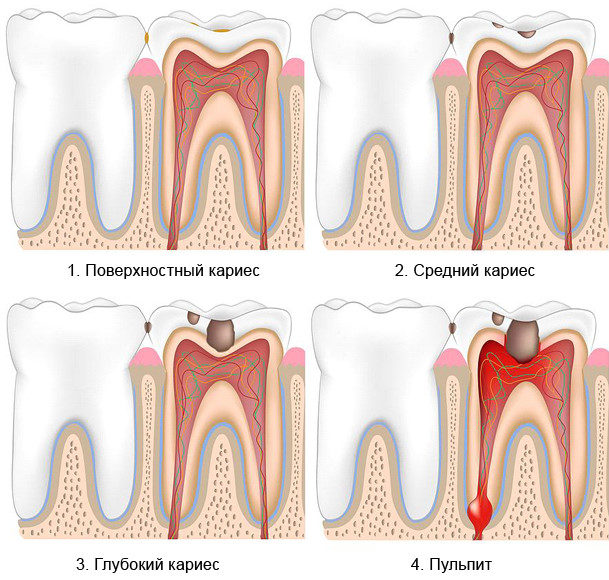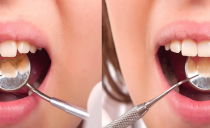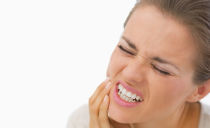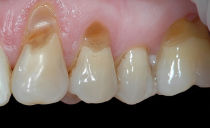The causes and stages of development of dental caries
Tooth decay and the causes of its occurrence have been the subject of study by scientists and dentists for more than a century. Trying to determine the source of the problem, they investigated many favorable conditions for a carious disease, among them: microorganisms present in the oral cavity, a malfunction of the immune system, eating habits, and poor dental care.
Scientists have not been able to come to a consensus so far, however, today we can single out a group of factors whose cariogenic effect has been confirmed at a scientific level.
Content
Why does tooth decay appear?
Caries is formed due to the destructive effect of bacteria on hard dental tissues. The microflora of the oral cavity is composed of a wide variety of microorganisms, the number of which is controlled by the human immune system. Under favorable conditions, for example, if hygiene is not observed or during an immune failure, microbes begin to multiply actively, affecting tooth enamel. Within 3-4 hours after brushing your teeth, the number of bacteria in your mouth can increase to 1 million.
The main "culprits" of caries are streptococci - Streptococcus mutans and Streptococcus sanguis. However, the activity and harmfulness of these bacteria manifests itself in different ways and depends on the resistance of the organism of a particular person and the presence of predisposing factors.
Factors contributing to the development of caries
The most rapid caries develops in places where plaque accumulates: in the interdental spaces, in the recesses between the chewing tubercles, in the cervical region. Therefore, dentists consider the main reason for the appearance of caries to be insufficient oral hygiene.
Inadequate care
The sad consequence of poor dental care is the formation of plaque on them gray, yellow or brown. Plaque occurs on the surface of the tooth due to accumulation of saliva and small food debris.
Plaque in itself does not contribute to the destruction of tooth tissues, but it is a breeding ground for cariogenic microorganisms.
With the accumulation of plaque, microbes begin to multiply and subsequently gradually corrode the tooth enamel. At this time (during the first eleven to twelve hours), it is still possible to suspend the carious process by removing the soft coating in time. After two or three days, it will become more difficult to clean the teeth of plaque, since it is saturated with calcium salts and will turn into hard tartar.
Normal brushing at this stage of the disease is useless, enamel destruction occurs around the clock. The only way out is to turn to the help of modern dentistry. The doctor will remove rotten hard tissues, stone, plaque and neutralize cariogenic bacteria.
Immune Failure
Temporary or permanent weakening of the body's defenses entails the growth of pathogenic microflora, which contributes to the development of caries. It is noticed that when a person is sick or takes antibiotics, caries goes to the next stage much faster. This observation gave scientists a reason to consider immune failure as one of the factors under the influence of which caries appears.
Attention! Not only failure of immunity can contribute to the development of caries, there is an inverse relationship between these processes: any form of caries contributes to a weakening of immunity. A carious lesion can lead to inflammation of the gums, soft tissues, the development of infectious diseases of the nasopharynx, upper respiratory tract and even internal organs, therefore it is necessary to get rid of cariogenic microorganisms even if a person has caries in the spot stage.
Vitamin deficiency
Poor nutrition, a weakened state of the body after an illness, a predominance of flour and sweet in the diet - all these factors increase the risk of tooth decay several times. Deficiency of vitamins and minerals affects the condition of enamel and dentin, as a result of which the tissues become more accessible to bacteria that cause tooth decay.
The menu should include:
- calcium rich dairy products;
- whole grain cereals;
- food to be chewed actively.
The content of solid foods in the diet: fruits, non-cooked vegetables, nuts - allows for additional mechanical cleaning of the teeth. But the introduction of solid food into the diet does not cancel the rules of daily hygiene.
Saliva composition
The disrupted chemical composition of saliva is another factor attributed by scientists to the causes of caries. If the percentage of salts in a person’s saliva is altered, they are much more likely to experience carious foci.
Ideally, human saliva should contain:
- lysozyme disinfecting the oral cavity;
- carbohydrate-breaking amylase;
- water - 90%.
The pH level of saliva should correspond to a slightly alkaline reaction (from 5.6 to 7.5). With the regular use of carbohydrate-rich foods, a pH shift occurs towards an acid reaction, which causes tooth decay.
Crowding of teeth
The abnormal position of the teeth with crowding (lack of space) can also provoke the destruction of enamel and the appearance of caries. Interdental spaces become inaccessible to the brush, irrigator, floss. It is impossible to clean them without the help of a dentist, therefore, plaque forms and accumulates in such places, bacteria multiply.
Timely treatment to the orthodontist will save you from the appearance of painful carious foci - it is better to correct the position of crowded teeth in childhood or adolescence, when the teeth are more amenable to orthodontic treatment.
Bad drinking water
The increased content of chlorine, copper and nickel in drinking water is dangerous for the whole organism, but primarily for teeth. Enamel can not cope with aggressive effects, as a result, cracks and whitish spots form on it.
The percentage of fluoride in the water also matters: too much of this trace element can contribute to the onset of fluorosis symptoms. At the initial stages, fluorosis is reversible - it is enough to filter tap water and visit the dentist regularly. At the middle stage of the disease, dentin decay begins; restoration of the esthetics of the dentition is possible with the help of micro prosthetics (veneers, lumineers).
General and local causes of dental caries
All the conditions that cause tooth decay can be divided into two groups:
- general, affecting the whole organism;
- local, originating in the oral cavity.
Are common
Common causes that may cause tooth decay include:
- improper nutrition, including diets that provoke a lack of nutrients;
- bad water;
- stress, extreme situations;
- hereditary violations of the structure of dental tissues, for example, enamel hypoplasia.
Many dentists attribute endocrine and somatic diseases to this group of factors. According to their observations, in patients with these pathologies, caries is more aggressive.
Local
Any disorder in the body can lead to the development of the disease, accompanied by a change in the composition of the microflora of the oral cavity. The prevalence of pathogenic bacteria over “useful” nullifies all efforts to care for your teeth.
Local sources of trouble:
- plaque;
- food particles regularly remaining in the mouth;
- injuries of teeth, gums, jaw;
- low degree of caries resistance.
The enamel resistance to caries is ensured by the optimal content of fluoroapatites and apatites in it with a Ca / P coefficient of 1.6 to 2. The distortion of the formula increases the susceptibility of dental tissues to the disease. How to fix the situation, the doctor will tell.
Stages of caries development
The carious process develops gradually. Dentists distinguish 4 stages of this disease:
- Caries in the spot stage. One or several spots of white or dark color appear on the enamel. Carious cavities at this stage of the development of pathology are absent.
- Surface stage. A carious cavity is formed within the enamel, the dentin of the tooth is not affected.
- Middle stage. The carious process extends to dentin, but does not affect the dentin layers surrounding the pulp of the tooth.
- Deep stage. The process of destruction affects the deep layers of dentin and rushes to the pulp. Outwardly, the lesion looks like a deep carious cavity. After this stage of the disease, pulpitis develops - inflammation of the pulp.
What aggravates the disease
According to doctors, the main scourge of modern dentistry is the patient’s attempt to cope with the disease on their own. Abrasive materials, sharp objects, household cleaners in the form of powders, alkaline and acid solutions of high concentration are used. All these "tools" are not aimed at combating the formation of new foci, but at the removal of those that have already appeared. Without understanding why caries appears, a person tries to erase darkened spots from a tooth on his own. The result is a damaged tooth surface, pain, deep tissues that are open for infection, and an accelerated carious process.
The severe consequences of self-medication, doctors include an abscess and intoxication, which often causes death. Not knowing what complications these or other “anti-carious” drugs will cause, you should not use them. Today, dentists help patients with the most advanced forms of caries, so it is better not to wait for the complications of this disease and consult a doctor in a timely manner.

